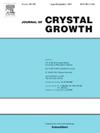底部支撑柱和冷却速度对蓝宝石基底表面形状特征的影响
IF 1.7
4区 材料科学
Q3 CRYSTALLOGRAPHY
引用次数: 0
摘要
蓝宝石衬底的制造过程涉及几个关键步骤,包括外延、退火、切割和加工。其中,外延和退火尤为关键。在结晶过程中,炉内纵轴和横轴的温度变化对蓝宝石晶体的结晶速度和内部结构起着重要作用。此外,蓝宝石退火还可减轻内应力、增强晶体结构、优化物理特性、改善光电特性、提高表面质量和增加总产量。这一步骤对于提高蓝宝石材料的性能和应用价值至关重要。为了研究和优化不同导热系数的基底支撑柱和各种退火程序对蓝宝石基底表面特性的影响,从而提高产品质量,本研究通过使用不同材料制成的支撑柱和仔细控制蓝宝石的冷却速率参数进行了研究。研究结果表明,使用石墨作为晶体炉的基础支撑柱,可以减少炉内的纵向和横向温度梯度,从而促进晶体生长,提高蓝宝石铸锭的质量。此外,使用一步法快速退火程序退火的蓝宝石芯片的平均翘曲和弯曲率变化最大,达到 2.0 μm,平均位错密度为传统生产芯片的一半,为 108.89 pits/cm2。本文章由计算机程序翻译,如有差异,请以英文原文为准。
Influence of bottom supporting columns and cooling rate on the surface shape characteristics of sapphire substrates
The manufacturing process of sapphire substrates involves several key steps, including epitaxy, annealing, cutting, and processing. Among these, epitaxy and annealing are particularly crucial. The temperature variances along both the longitudinal and transverse axes within the furnace during the crystallization process play a significant role in determining the crystallization rate and internal structure of sapphire crystals. Furthermore, annealing sapphire serves to alleviate internal stress, enhance crystal structure, optimize physical properties, improve optoelectronic characteristics, enhance surface quality, and increase overall yield. This step is paramount in enhancing the performance and application value of sapphire materials. In order to investigate and optimize the effects of different thermal conductivities of support columns at the base and various annealing procedures on the surface characteristics of sapphire substrates, thereby improving product quality, this study conducted research by utilizing support columns made of different materials and carefully controlling the cooling rate parameters for sapphire. The findings revealed that using graphite as the base support column for the crystal furnace can reduce both the longitudinal and transverse temperature gradients within the furnace, consequently promoting crystal growth and enhancing the quality of sapphire ingots. Additionally, sapphire chips annealed using the rapid one-step annealing program exhibited the highest average warpage and bending rate variation, reaching 2.0 μm, and the average dislocation density was half that of conventionally produced chips, at 108.89 pits/cm2.
求助全文
通过发布文献求助,成功后即可免费获取论文全文。
去求助
来源期刊

Journal of Crystal Growth
化学-晶体学
CiteScore
3.60
自引率
11.10%
发文量
373
审稿时长
65 days
期刊介绍:
The journal offers a common reference and publication source for workers engaged in research on the experimental and theoretical aspects of crystal growth and its applications, e.g. in devices. Experimental and theoretical contributions are published in the following fields: theory of nucleation and growth, molecular kinetics and transport phenomena, crystallization in viscous media such as polymers and glasses; crystal growth of metals, minerals, semiconductors, superconductors, magnetics, inorganic, organic and biological substances in bulk or as thin films; molecular beam epitaxy, chemical vapor deposition, growth of III-V and II-VI and other semiconductors; characterization of single crystals by physical and chemical methods; apparatus, instrumentation and techniques for crystal growth, and purification methods; multilayer heterostructures and their characterisation with an emphasis on crystal growth and epitaxial aspects of electronic materials. A special feature of the journal is the periodic inclusion of proceedings of symposia and conferences on relevant aspects of crystal growth.
 求助内容:
求助内容: 应助结果提醒方式:
应助结果提醒方式:


